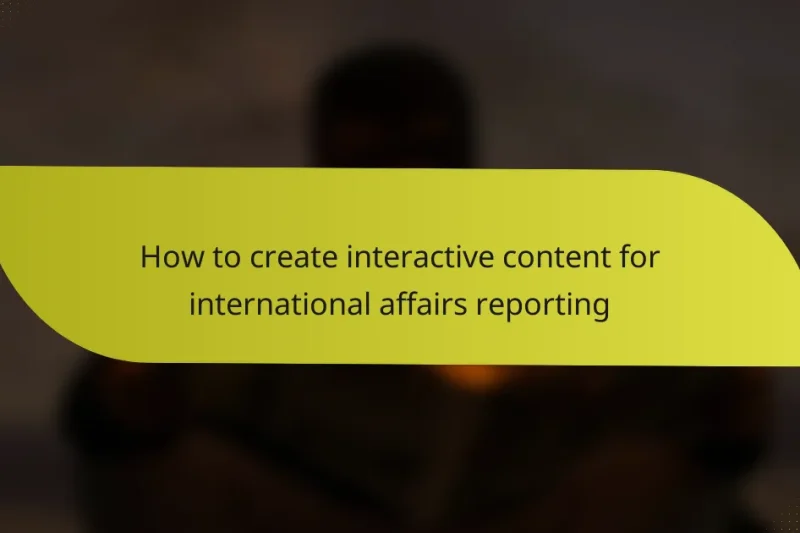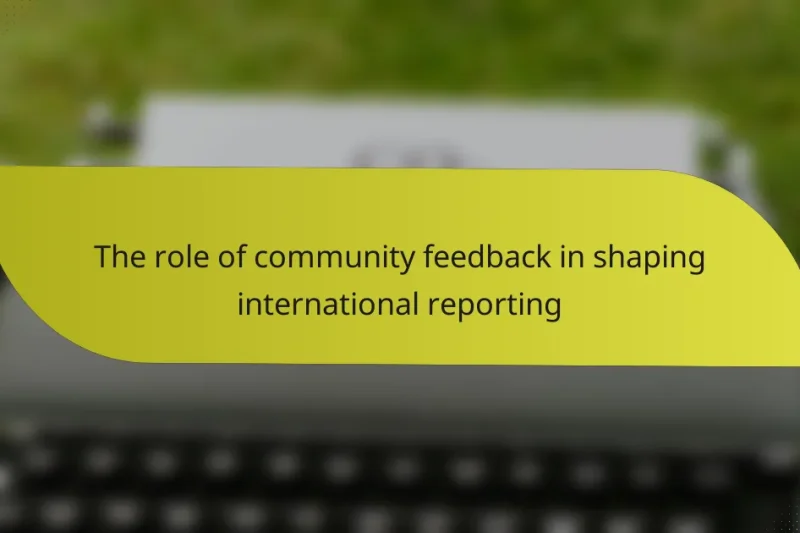Tailoring content for diverse cultural audiences in reporting is essential for effective communication and engagement. By … How to tailor content for diverse cultural audiences in reportingRead more
Audience Engagement Strategies in International Affairs Reporting
In the realm of international affairs reporting, effective audience engagement strategies are crucial for making complex global issues more relatable and accessible. Techniques such as interactive storytelling, data visualization, and social media integration not only enhance understanding but also foster active participation. By leveraging multimedia content, reporters can create immersive experiences that resonate with diverse audiences and encourage meaningful dialogue.
How to create interactive content for international affairs reporting
Creating interactive content for international affairs reporting can greatly enhance audience engagement and understanding of complex … How to create interactive content for international affairs reportingRead more
The role of community feedback in shaping international reporting
Community feedback is essential in shaping international reporting, as it provides valuable insights that enhance the … The role of community feedback in shaping international reportingRead more
Best practices for building a loyal audience in international journalism
Building a loyal audience in international journalism hinges on authenticity, relevance, and active engagement. By delivering … Best practices for building a loyal audience in international journalismRead more
Strategies for engaging younger audiences with international news
Engaging younger audiences with international news requires innovative strategies that resonate with their preferences and communication … Strategies for engaging younger audiences with international newsRead more
Comparing audience engagement metrics across different platforms
In the ever-evolving landscape of social media, audience engagement metrics differ widely across platforms, with Instagram … Comparing audience engagement metrics across different platformsRead more
Using podcasts to boost audience engagement in global issues
Podcasts serve as a powerful tool for boosting audience engagement on global issues by delivering accessible … Using podcasts to boost audience engagement in global issuesRead more
What are effective audience engagement strategies in international affairs reporting?
Effective audience engagement strategies in international affairs reporting include interactive storytelling, data visualization techniques, social media integration, and live reporting with Q&A sessions. These methods enhance audience understanding and participation, making complex global issues more relatable and accessible.
Interactive storytelling
Interactive storytelling involves creating narratives that allow audiences to engage with content actively. This can include multimedia elements such as videos, infographics, and clickable maps that provide deeper insights into international events. For example, a news outlet might use an interactive timeline to illustrate the progression of a diplomatic negotiation.
To implement this, consider using platforms that support interactive content, ensuring that the design is user-friendly and visually appealing. Avoid overwhelming users with too much information at once; instead, guide them through the story step-by-step.
Data visualization techniques
Data visualization techniques help simplify complex information, making it easier for audiences to grasp key statistics and trends in international affairs. Charts, graphs, and heat maps can effectively convey data about global issues such as migration patterns or economic indicators. For instance, a bar chart comparing GDP growth rates across different countries can provide immediate context for economic discussions.
When using data visualizations, ensure that they are clear and accurately represent the data. Use contrasting colors and labels to enhance readability, and provide context to avoid misinterpretation. Aim for simplicity to keep the audience focused on the main message.
Social media integration
Social media integration allows for real-time interaction and feedback from audiences, making reporting more dynamic. By sharing content on platforms like Twitter, Facebook, and Instagram, reporters can reach a broader audience and encourage discussions around international issues. For example, live-tweeting an international summit can engage users and provide immediate updates.
To maximize effectiveness, tailor content to each platform’s audience and format. Use hashtags to increase visibility and encourage user-generated content. Be responsive to audience comments and questions to foster a sense of community and involvement.
Live reporting and Q&A sessions
Live reporting and Q&A sessions offer audiences the opportunity to engage directly with journalists and experts during significant international events. This approach can include live blogs, webinars, or social media live streams where viewers can ask questions in real-time. For example, hosting a live Q&A after a major international agreement can clarify details and address public concerns.
To execute this effectively, promote the event in advance and encourage audience participation. Prepare for common questions and have experts on hand to provide accurate answers. Ensure that the technology used for live sessions is reliable to avoid technical issues that could hinder engagement.
How can international affairs reporters leverage social media for engagement?
International affairs reporters can effectively use social media to engage their audience by sharing timely updates, fostering discussions, and building communities around global issues. Platforms like Twitter and Facebook offer unique opportunities for real-time interaction and deeper conversations with followers.
Utilizing Twitter for real-time updates
Twitter is ideal for delivering immediate news and updates on international events. Reporters can share breaking news, important announcements, and live commentary, often within seconds of an occurrence. This immediacy helps keep followers informed and engaged.
To maximize impact, reporters should use relevant hashtags to reach broader audiences and participate in trending conversations. Engaging with followers through replies and retweets can also enhance visibility and foster a sense of community.
Creating Facebook groups for community discussions
Facebook groups provide a platform for in-depth discussions among individuals interested in international affairs. Reporters can create dedicated groups to facilitate dialogue, share insights, and gather diverse perspectives on global issues. This encourages active participation and builds a loyal audience.
When managing a group, it’s essential to establish clear guidelines for discussions to maintain a respectful environment. Regular posts, polls, and Q&A sessions can stimulate engagement and keep members invested in the conversation.
What role does multimedia play in audience engagement?
Multimedia significantly enhances audience engagement in international affairs reporting by providing diverse content formats that cater to different preferences. By integrating visuals, audio, and interactive elements, reporters can create a more immersive experience that captures attention and fosters understanding.
Incorporating video interviews
Video interviews offer a dynamic way to present expert opinions and firsthand accounts in international affairs. They allow viewers to connect emotionally with the subjects, enhancing relatability and trust. When producing video content, ensure high-quality visuals and sound, and keep interviews concise—ideally under ten minutes—to maintain viewer interest.
Consider using subtitles to make videos accessible to a broader audience, including non-native speakers. Platforms like YouTube or social media channels can amplify reach, so tailor content to fit the platform’s audience and engagement style.
Using podcasts for in-depth analysis
Podcasts serve as an effective medium for delivering detailed analysis on complex international issues. They allow for deeper exploration of topics, often featuring expert guests who provide valuable insights. Aim for episodes that are 20 to 60 minutes long, striking a balance between depth and listener retention.
To maximize engagement, promote interactivity by encouraging listener questions or feedback through social media. Additionally, consider creating themed series that delve into specific regions or topics, which can help build a loyal audience over time.
What are the best practices for audience feedback in reporting?
Best practices for audience feedback in reporting involve actively seeking input through various channels and responding to that feedback to enhance engagement. This not only improves the quality of reporting but also fosters a sense of community among readers.
Conducting surveys for audience insights
Surveys are an effective tool for gathering audience insights, allowing reporters to understand preferences and interests. They can be distributed via email, social media, or embedded on websites, and should include a mix of open-ended and multiple-choice questions to capture diverse opinions.
To maximize response rates, keep surveys concise and offer incentives such as entry into a prize draw. Aim for a completion time of under five minutes to encourage participation, and consider segmenting your audience to tailor questions more effectively.
Implementing comment sections for discussions
Comment sections enable direct interaction between reporters and their audience, fostering discussions around articles. They should be moderated to maintain a respectful environment and to prevent spam, ensuring that constructive feedback is prioritized.
Encourage engagement by asking open-ended questions at the end of articles and responding to comments regularly. This not only shows that you value audience input but also helps build a loyal readership. Consider using tools that allow for upvoting or highlighting insightful comments to further enhance community interaction.
How can international affairs reporting adapt to cultural differences?
International affairs reporting can adapt to cultural differences by recognizing and respecting the diverse values, beliefs, and communication styles of various audiences. Tailoring content to reflect local contexts enhances relevance and fosters engagement.
Tailoring content for local audiences
To effectively tailor content for local audiences, reporters should incorporate culturally significant references and language that resonate with the target demographic. This may involve using local dialects, idioms, or examples that reflect regional issues.
For instance, when covering a political event in Eastern Europe, using terms familiar to the local populace, such as “BGN” for Bulgarian Lev, can create a stronger connection. Additionally, highlighting local perspectives on global issues can make the content more relatable.
Understanding regional media consumption habits
Understanding how different regions consume media is crucial for effective international reporting. For example, some cultures may prefer in-depth analysis, while others favor concise summaries. Knowing whether audiences engage more with television, online platforms, or print can shape content delivery.
Research indicates that in many Asian countries, mobile consumption is predominant, suggesting that reports should be optimized for mobile viewing. Engaging with local influencers or media outlets can also enhance visibility and credibility within specific markets.
What metrics should be used to measure engagement effectiveness?
To measure engagement effectiveness in international affairs reporting, key metrics include website traffic, user interaction rates, and social media shares. These metrics provide insights into how audiences are consuming content and their level of interest.
Analyzing website traffic and user behavior
Website traffic analysis involves tracking the number of visitors, page views, and session duration on your reporting site. Understanding these metrics helps identify which articles attract the most attention and how long users stay engaged with the content.
Tools like Google Analytics can provide detailed insights into user behavior, such as bounce rates and traffic sources. High bounce rates may indicate that content is not resonating with visitors, while longer session durations suggest deeper engagement.
Consider segmenting your audience based on demographics or geographic location to tailor content more effectively. For example, if a significant portion of your traffic comes from Europe, you might focus on European affairs to enhance relevance and engagement.






